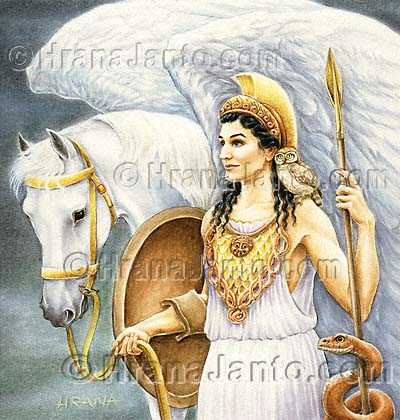Strength
Grey-eyed one, I sing of you, wisest
and most beautiful,
relentless Athena, protector of
cities, strong-armed and fair.
Hail to you, Athena, may I never
live without the shield of your protection.
This Homeric Hymn honors a goddess
who, coming to the Greek mainland
from her original home in Crete,
became ruler of the primary city of the ancient world while maintaining
many symbols of her ancient identity. Greek myth tells of a contest
between Athena and Poseidon, blue-skinned god of the sea. Both wanted
to rule the Greek city, and neither would give way to the other.
Finally, a vote was called, and the citizens- men and women alike- gathered
to cast their ballots. Not surprisingly, the men voted for the god,
the women for the goddess. The odds were in Athens favor, for there
was one more voter on the women's side. And so the city became Athens,
city of the goddess.
The men accepted the ballot's results rather bitterly. They struck back at the women by passing three new laws: they barred women from voting, stripped them of citizenship, and gave children the father's name rather than the mother's. Athena, too, they altered beyond recognition, making up a story of her motherless birth from the head of the chief god. In this now familiar story of Athena's genesis, she appears completely male identified. But another story exists that shows the goddess in a different light. Athena, it says, was a daughter of Pallas, a winged giant who tried to rape his virginal daughter. She killed him, then tanned his skin to make a shield and cut off his wings to fasten to her feet.
However she came by her fierceness, Athena never consorted with men, remaining forever a virgin.

Symbols of Athena
Athena is most vividly symbolized
by the snake which, in the famous statue in her main temple, rears up beside
her, taller than any human viewer.
Armor and weapons are also among
Athena's symbols. She was frequently sculpted wearing a helmet, carrying
a shield or spear.
The most charming of Athena's symbols
is that of the owl, which appears on early Athenian coins as an alternative
image to the goddess in human form. In some statues and paintings,
an owl sits on the goddess's shoulder.
Patricia Monaghan

Athena Holy Virgin; Maiden Goddess;
Mother Goddess of Athens; Bright Eyed.
An all powerful warrior goddess,
but she disliked senseless violence.
Sometimes called Pallas Athene
in memory of the goddess' close friend whom she accidentally killed in
practice. The Parthenon, "Virgin Temple," was her shrine. Sacred
to her were the owl, olive, oak, intertwined snakes.
She wore a helmet and aegis (breastplate)
and carried a shield and spear. She invented the plow, bridle, rake,
ox yoke, chariot, and flute; also taught humankind to breed and break horses.
She was celebrated at the Lesser Panthenaea in March and on the Day of
the Geniae on December 25. She was a goddess of freedom and women's
rights; patroness of craftsman, especially smiths, goldsmiths, potters,
dressmakers, shipbuilders, weavers and spinners. Also the patroness
of career women. She was the protector of cities and patron of soldiers.
She was the goddess of protection, writing, music, the sciences, sculptors,
potters, architects, wisdom, arts and skills, renewal, true justice, protection
(both psychic and physical), prudence, wise counsel, peace, embroidery,
horses and oxen, snakes, pillars, trees, olive boughs, battle strategy.
D.J. Conway

Aegis
Goatskin breastplate of the Goddess
Athene, ornamented with oracular serpents and the petrifying head of Medusa.
The original Libyan Athene was herself the Gorgon mask surrounded by serpents,
served by priestesses who wore the aegis as a goatskin apron. It
was a badge of divine power. Later Homeric myths considered the aegis
so essential to sovereignty that not even Zeus could rule the other gods
without it.
B.Walker

Athene came from North Africa.
She was the Libyan Triple Goddess Neith, Metis, Medusa, Anath, or Ath-enna.
An inscription at Larnax-Lapithou named her Athene in Greek, Anat in Phoenician.
Pre-Hellenic myths said she came from the uterus of Lake Tritonis (Three
Queens) in Libya. Egyptians sometimes called Isis Athene, which meant
"I have come from myself."
Greeks claimed Athene was born
from Zeus's head, after he swallowed her mother Metis, i.e. Medusa, "Female
Wisdom," formerly symbolized by the Gorgoneum, Athene's snake haired mask,
invested with power to turn men to stone. Gorgo, or Gorgon, was Athene's
Destroyer aspect.
B.Walker

Home /